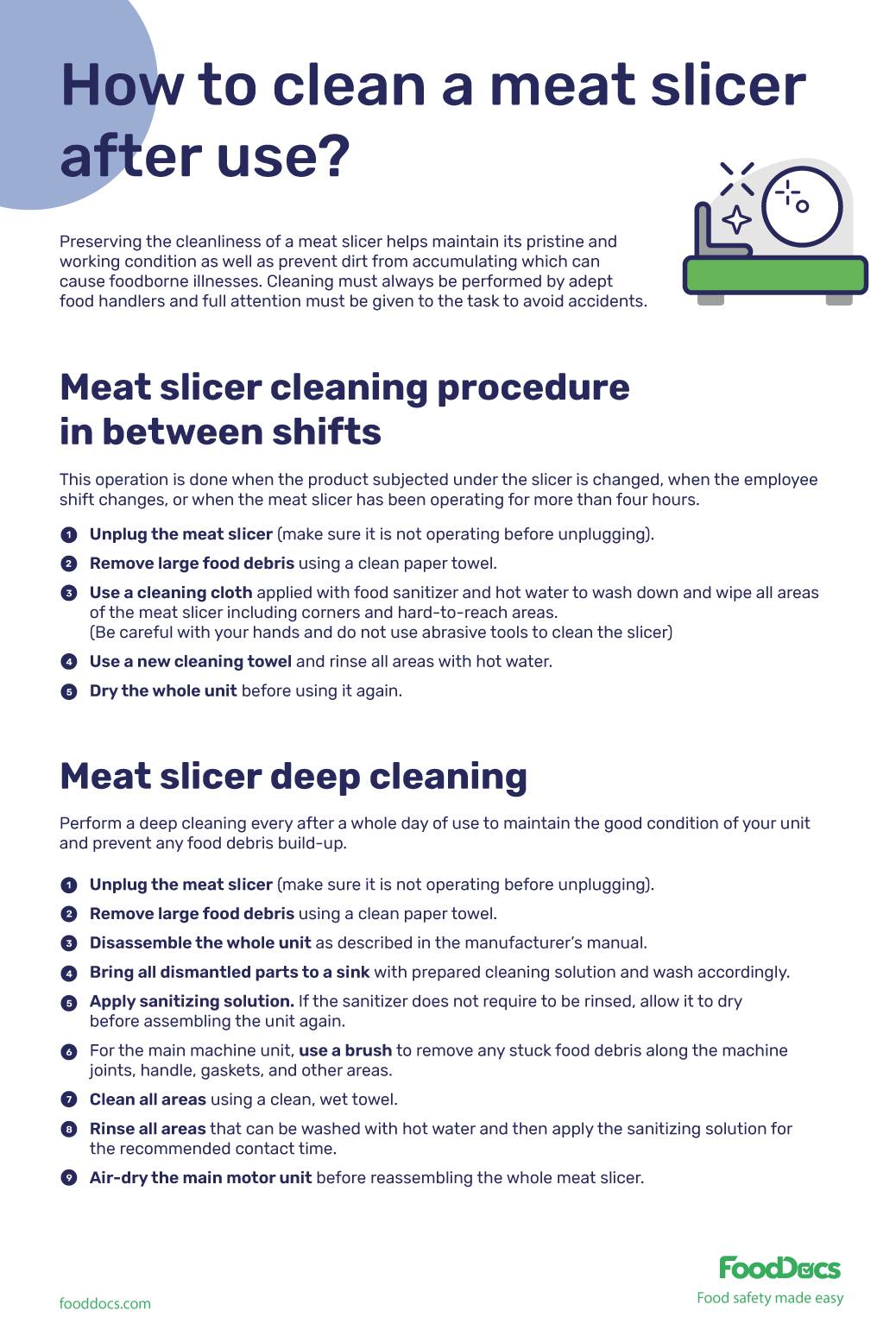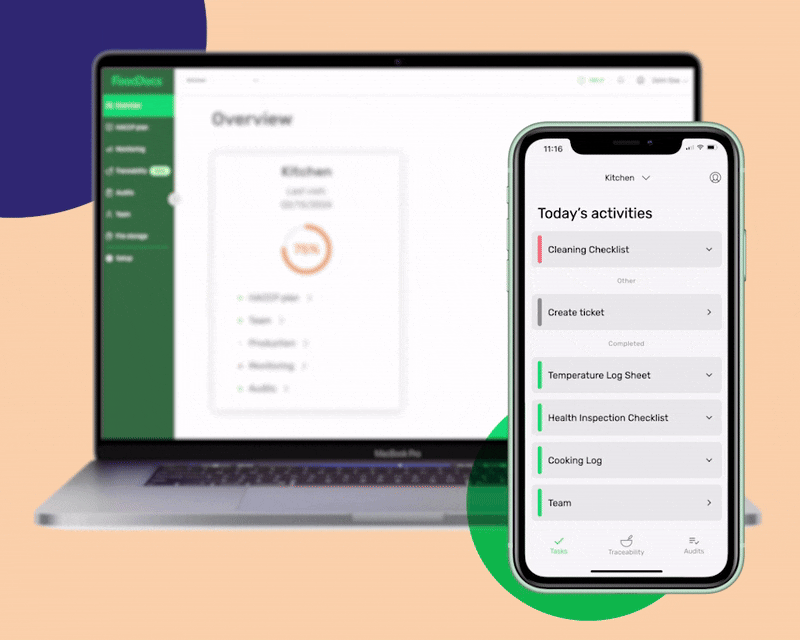Why Is Food Safety Important In Healthcare? Healthcare Leaders Guide
Learn challenges healthcare foodservice teams face today and key food safety practices to protect vulnerable patients. Get a free healthcare leader...
Machines used in the kitchen always make processing easy. The work gets done faster and the results are always uniform, allowing food handlers to maintain high standards for food safety.
Despite this, some machines including meat slicers may harbor pathogenic organisms around or in between their joints and in narrow crevices. Food debris that gets stuck can attract harmful bacteria, spoil, contaminate all succeeding foods to be processed, and ultimately cause foodborne illnesses. As such, it is important to always keep machines well-maintained and clean.
WHAT WE'LL COVER:
Based on the recommendation of the FDA Food Code on how often how should a meat slicer be cleaned, meat slicers in addition to contact surfaces must be cleaned and sanitized every 4 hours when constantly in use. For this case as well as for every shift change, light cleaning can be done for faster but effective removal of stuck pieces of meat.
In answering how often should a meat slicer be cleaned, the frequency of use is significantly considered. Cleaning the meat slicer frequently allows a food handler to easily remove foods from the crevices and machine joints. If you allow them to stay longer than 4 hours, they can harden and become tougher to remove.
For deep cleaning, a meat slicer must be cleaned and sanitized every day as the working day ends. This operation includes dismantling and vigorously washing the machine for a more thorough cleaning.
Deep cleaning cannot be done every shift change because the operation takes time and effort. It usually involves careful inspection of every part in addition to cleaning. Only an assigned and trained food handler must be allowed to perform a deep cleaning to ensure the machine will not be damaged.


Thank you for downloading Food product specification sheet!
Want to get a customizable HACCP template?
Or set up your food safety system in 15 minutes?
Food safety authorities such as the Food and Drug Administration (FDA) impose strict food sanitation rules when it comes to cleaning kitchen equipment and the entire food facility. A meat slicer handles several batches of raw meats in a day and can easily collect debris from a processed food item and accumulate bacteria over time.
Cleaning a meat slicer can be tricky and a bit dangerous. Full attention, an alert mind, and knowledge of how to clean a meat slicer must be always present during the operation.
A meat slicer is a very common piece of equipment used in food establishments such as deli shops or a restaurant serving meat dishes. It can also be found in other food businesses, usually, those preparing in bulk, such as a cafeteria or food catering service.
Depending on the volume of food being served in a food business, the number of raw meats being processed in a meat slicer can also vary. In a deli shop, you would typically think that a meat slicer would run for quite a while.
After using a meat slicer, you should always clean it whether using light or deep cleaning operations. Cleaning a meat slicer requires focus and precision. Steps such as correct dismantling and thorough washing must always be observed.
Additionally, post-operational checkups must be done to detect problems such as chipped blades or loose joints. Regularly cleaning a meat slicer would allow operators to check for any condition that may affect the performance and safety of the machine.

Meat slicers are used to process different types of raw meats. This means that the machine comes in contact with bits of meat, meat juices, fats, and sometimes even bones. Meat components may work their way to the nooks and crannies of a meat slicer and harbor foodborne pathogens. When unmaintained, your meat slicer can become a source of cross-contamination and potentially cause a foodborne illness outbreak.
The FDA has previously identified that several foodborne illness outbreaks are attributed to food debris build-up on deli slicers and have become contaminated over time. Regular cleaning, although may seem too tedious, is a requirement to keep the meat slicer working and safe for a long time. When foods have built up along the joints of the slicer and stayed there for too long, the debris may become too hard to remove.
Additionally, cleaning and sanitizing routines may also encourage food handlers to check the condition of the meat slicer. The excess moisture from any raw meat and unchecked food debris may cause some parts of the meat slicer to acquire rust and contaminate succeeding products to process.
Food handlers must always be conscious of following the correct cleaning and sanitizing procedure. Not to mention that the schedule for cleaning must be religiously followed for consistent food safety. To help your team remember every sanitation task, use our digital Food Safety Management System.
With our digital solution, you can get an intuitive system that can automatically generate monitoring forms and checklists with detailed instructions for sanitation and cleaning. Our system also includes a smart notification program that alerts food handlers to remind them of food safety tasks. You can rest easy that every food safety task will be done efficiently and on time.
To properly clean a commercial meat slicer, there are two types of operations: light and deep cleaning. Both processes involve removing the visible meat debris as well dried up blood and potential bone chips through manual means. They also involve wiping down the whole unit with a clean cloth.
Generally, your meat slicer must be lightly clean after every shift. Some of the operations involved in light cleaning may be used for cleaning the meat slicer every 4 hours as per FDA recommendations.
Additionally, when products subjected under the meat slicer are changed, the machine must be lightly cleaned. Light cleaning is done to ensure that the processed food debris does not stick to the meat slicer and can be easily removed when needed.
Light cleaning is performed using the following simple steps:
Every after a working day ends, your meat slicer machine must be thoroughly cleaned. To do this, the machine needs to be disassembled, vigorously washed, and sanitized accordingly. A quick wash or light cleaning will not suffice to prevent foodborne pathogens such as harmful and common bacteria from building up on your slicer. Thorough or deep cleaning will allow food handlers to also check the status of the meat slicer and maintain its good working condition.
The following are steps for deep cleaning:
Here are a few more frequently asked questions about how to meat slicers:
Yes! In learning how to cut frozen meat, a handy meat slicer could do the work best. Some suppliers deliver blocks of frozen meat to food establishments in bulk. Thawing this delivery before slicing increases the risk of contamination. A meat slicer can easily cut through a block of frozen meat depending on the size of the frozen batches.
For smaller cuts of frozen meat, a meat slicer would do well in slicing it even more. Depending on the maximum capacity of your meat slicer, you may still have to break down larger pieces of frozen meat.
Some meat slicers come with a whetstone attachment that is convenient for sharpening your stainless steel blade. Make sure that the machine is disconnected and clean the blade for safety before sharpening. Any food debris will make the sharpening process ineffective. Sharpening is done for about 30 seconds and repeated three times in a row.
A meat slicer is also called a deli slicer. A deli slicer is cleaned using a clean cloth, soapy water, and a sanitizer.

Cleaning and sanitation of your professional meat slicer is the best proper maintenance for the machine. Additionally, tips such as not using abrasive cleaning tools may help extend the good condition of your machine. Regularly performing and monitoring both tasks are keys to preventing food poisoning from occurring and are part of basic met slicer maintenance.
To improve efficiency and accountability regarding your cleaning routine, your food safety management system must include monitoring procedures as well as a cleaning schedule regarding the meat slicer. Time, frequency, and accuracy of the operation will significantly affect the safety of the foods being produced in your food business.
To help you in monitoring cleaning and sanitizing your meat slicer, use our smart solution at FoodDocs. Using our digital Food Safety Management System, every food handler tasked with cleaning the meat slicer will always be alerted to perform the operations. Using our mobile application, our system can send intuitive notifications to alert an employee to clean the meat slicer on time. Additionally, our system can automatically generate a digital monitoring form built specifically for meat slicer cleaning and sanitizing procedures.
During cleaning and sanitizing, you may want to check particular areas such as the slicer blade, gaskets, joints, slicer handle, blade guard, and ring guard. These areas are where most food particles are collected and are harder to clean. Thorough cleaning of these parts needs disassembly so you would be able to reach crevices and behind them such as for the slicer blade.
Additionally, these areas are known to require more maintenance. Chips, rust, and broken parts may occur during slicing and you would only be able to detect these when you deep clean the slicer. Immediate detection can make way for the application of corrective actions and to bring the attention of the team to maintaining the meat slicer.
During cleaning and sanitizing a meat slicer, few operations can be done to improve safety for the food handler and efficiency for cleaning. A meat slicer, especially its blade, can be very dangerous when operated by someone who does not have good background knowledge of its functions. As such, here are some tips to take note of when attempting to clean a meat slicer:
Like any other machine, a meat slicer requires to be operated professionally to keep its effectiveness for a long time. Misuse and improper cleaning may lead to damage and cause the meat slicer to become ineffective. Make sure to regularly conduct cleaning and sanitizing to prevent foodborne illnesses and maintain the equipment.

Meat slicers are not the only equipment that you may need to monitor. If you use a restaurant cleaning checklist, you would figure out that in addition to ensuring proper use of these machines, you also need to monitor a lot of cleaning operations.
Monitoring these tasks and the supervision of food handlers are essential to ensure that food safety is preserved and that every kitchen equipment is properly maintained. With all of these monitoring and verification tasks, how do you expect to handle the business side of your food safety establishment?
Even with a traditional food safety management system, you would have to do everything manually. What you need in your food business is our digital Food Safety Management System.

Powered by artificial intelligence, our system can automatically generate a comprehensive digital FSMS built specifically based on your operations. Our system uses smart tools to help you intuitively monitor your food safety tasks every day.
With our digital solution, you can get monitoring forms and checklists that suit your operations. To help in maintaining your meat slicer, you can use our automatically generated Sanitation schedule and Master Sanitation Checklist.

Sanitation and Cleaning Checklist

Master Sanitation Schedule
In addition to cleaning and sanitation documents, our system also includes monitoring forms for equipment maintenance. You can use this form to log any faulty observations for your meat slicer and attach images as proof. Our system can immediately send an alert to the concerned department and address the issue as soon as possible.

Equipment Maintenance Log
Getting our digital FSMS product is not even hard! All it takes is for your to answer a few basic questions to describe your food safety operations and our system will do the rest. In about 15 minutes, you can get an automatically generated digital FSMS. This product can provide you with the following features:
With our digital FSMS, all food safety monitoring tasks can become more efficient and food safety compliance is ensured. Our system can even accommodate modifications to further tailor the generated digital FSMS to your food business. You can simply customize most parts, add more information, and improve the digital FSMS according to your needs.
Ensure that your meat slicers and all other food processing machines in your kitchen, are well-maintained and cleaned with our digital FSMS. Experience our product features yourself without the commitment using our free, 14-day trial. Get to try how efficient food safety compliance can be when you use our digital FSMS.
Learn challenges healthcare foodservice teams face today and key food safety practices to protect vulnerable patients. Get a free healthcare leader...
Learn what Standard Operating Procedures (SOPs) are and how to write effective SOPs that ensure consistency, efficiency, and safety in your...
Boost your retail food safety with essential practices and digital tools to protect customers and your brand. Plus a free Retail Food Safety Leader...